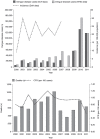Epidemiology of dengue disease in the Philippines (2000-2011): a systematic literature review
- PMID: 25375119
- PMCID: PMC4222740
- DOI: 10.1371/journal.pntd.0003027
Epidemiology of dengue disease in the Philippines (2000-2011): a systematic literature review
Abstract
This literature analysis describes the available dengue epidemiology data in the Philippines between 2000 and 2011. Of 253 relevant data sources identified, 34, including additional epidemiology data provided by the National Epidemiology Center, Department of Health, Philippines, were reviewed. There were 14 publications in peer reviewed journals, and 17 surveillance reports/sources, which provided variable information from the passive reporting system and show broad trends in dengue incidence, including age group predominance and disease severity. The peer reviewed studies focused on clinical severity of cases, some revealed data on circulating serotypes and genotypes and on the seroepidemiology of dengue including incidence rates for infection and apparent disease. Gaps in the data were identified, and include the absence incidence rates stratified by age, dengue serotype and genotype distribution, disease severity data, sex distribution data, and seroprevalence data.
Conflict of interest statement
RD and ML are employees of Sanofi Pasteur. JB is employed by Sanofi-Aventis. LB has received financial reimbursement from Pfizer to attend national and international congresses and lecture fees for attending a speakers bureau, and has acted as a consultant for Pfizer without financial reimbursement. VGR has no conflicts of interest to declare. This does not alter our adherence to all PLoS policies on sharing data and materials.
Figures




References
-
- Siler JF, Hall MW, Hitchens AP (1926) Dengue: its history, epidemiology, mechanism of transmission, etiology, clinical manifestations, immunity, and prevention. Philipp J Sci 29: 1–302.
-
- Simmons JS, St John JH, Reynolds FHK (1931) Experimental studies of dengue. Philipp J Sci 44: 1–247.
-
- Ooi EE, Gubler DJ (2009) Dengue in Southeast Asia: epidemiological characteristics and strategic challenges in disease prevention. Cad Saude Publica 25 (Suppl 1) S115–S124. - PubMed
-
- Gubler DJ (1997) Dengue and dengue hemorrhagic fever: its history and resurgence as a global public health problem. In: Gubler DJ, Kuno G, editors. Dengue and dengue hemorrhagic fever. Oxford: CAB International. pp. 1–22.
-
- Department of Health, Republic of Philippines (2010) National objectives for health, Philippines, 2005–2010. Available: http://www.doh.gov.ph/sites/default/files/NOH2005.pdf. Accessed 23 July 2013.
Publication types
MeSH terms
LinkOut - more resources
Full Text Sources
Other Literature Sources
Medical

